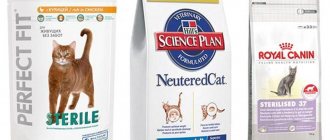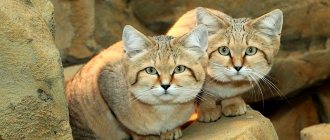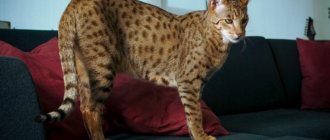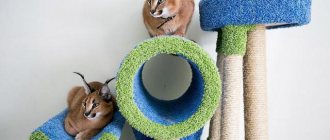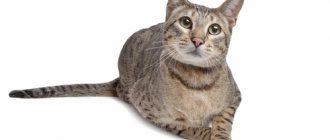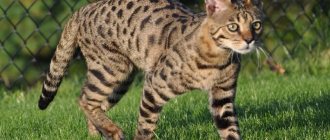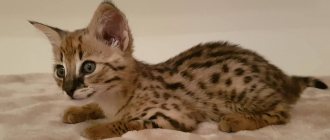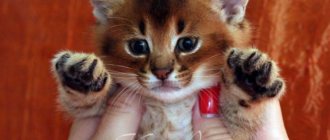The Asherah is a breed of American origin with a cheetah coloring that has captured the hearts of exotic cat lovers. She appeared thanks to the crossing of a Bengal cat with an African serval and still tops the list of the most expensive pets. At the beginning of the 21st century, the breed became the cause of a big scandal: it turned out that Ashera is an already well-known Savannah cat, which appeared in the 80s of the 20th century. This unexpected discovery caused confusion, which is why many experts considered the Asher and Savannah to be (and still consider) different breeds. Be that as it may, representatives of the breed remain an indicator of the prestige and success of the owner.
The history of the Asher cat breed
Experiments on mating a Serval with a Siamese were started by Pennsylvania breeder Judy Frank in 1986. Previously, she had successfully bred bush cats, but decided to inject new blood into the breed. To do this, Judy borrowed a male serval from her friend Susie Woods. The couple successfully completed the task, but force majeure happened: the cat took a liking to the breeder’s domestic cat, and love fell between them.
The result of adultery was the appearance of a cute cat. Susie Woods named the baby Savannah. This is how a new breed of hybrid cats appeared. Although Woods was not a professional, this did not prevent her from mating a Savannah cat with a domestic cat. Later, she even made several “expert” publications on this topic.
The main contribution to the development of the Savannah breed was made by Patrick Kelly, who bought a kitten from Susie Woods and enlisted the support of Joyce Sroufe, an experienced Bengal breeder. In 1996, Kelly and Sroufe demonstrated new and unique cheetah-colored cats to TICA and also provided the first Savannah standard.
In 2001, the breed received official registration and recognition, and Joyce Sroufe, in turn, became a mega-popular breeder.
Reference. Savannah has an exceptional memory, a lively mind and a passion for an energetic lifestyle. The main character trait of this cat is incredible devotion to its owner, which makes it look like a dog.
Who is Asherah
In reality, Ashera is just a product of a clearly structured advertising campaign by the head of Lifestyle Pets. The breed is still not recognized by any felinological organization. Events unfolded rapidly: in 2007, Lifestyle Pets introduced the world to large leopard-print cats and stated that they were the result of complex and lengthy experiments. The owner of the company, Simon Brody, assured that the breeding involved a domestic cat, a serval cat and an Asian leopard cat.
The highlight of the advertising campaign was the legend that Ashera is completely hypoallergenic. The assurances were supported by scientific studies paid for by Brody, which were supposed to confirm the absence of allergens in cat fur. However, not a single major publication took responsibility for publishing the results. By the way, it later turned out that the results were fictitious. However, Brody's dishonesty gave the breed good publicity. Wealthy breeders and exotic lovers lined up for ushers, and the Lifestyle Pets company became incredibly rich.
Brody's happiness did not last long: the myth about the unique breed was debunked by Chris Shirk, a breeder from Pennsylvania. In his official statement, he said that Lifestyle Pets employees bought several Savannahs from him and after some time introduced them as a new breed. An unheard of excitement arose again around the Asher and Dutch geneticists took up the study of the furry beauties.
It was they who brought clarity to this matter and proved that all Lifestyle Pets cats really belong to the Savannah breed. Moreover, the elite animals turned out to be in no way hypoallergenic and were no different from their outbred relatives. The deception was exposed, Brody was disgraced, but the popularity of the Savannahs themselves did not diminish at all, rather the opposite.
Interesting. The breed was named after the fertility goddess Asherah from Western Semitic mythology.
Mating
Before giving the Asher kitten to its new owner, it was sterilized - this was a mandatory condition. For this reason, breeding a pet at home was excluded. There are several explanations for this:
- a breeding secret that the breeders kept in the strictest confidence - mass breeding could lead to loss of income for Life Style Pets;
- as a result of splitting, the character of the animal could change, which is very dangerous, since the cat is quite large and strong, and this can bring tragic consequences for the owner and his family members.
But soon the scam was revealed. And today no one will buy an Asherah cat from the “official” manufacturer, since everyone knows that this breed is called the Savannah. The F1-F2 class savannah itself can cost up to $20,000.
Asherah: The largest and “wildest” domestic cat
Ashera is a cat with a wild appearance, natural charm, grace and elegance. Breeders claim that all this splendor is complemented by an easy-going nature and ease of care.
Characteristics of the breed and appearance of the Ashera
Savannah is a large cat: its body length reaches 1 m and its weight is 15 kg. Asheras do not have a breed standard, since felinological organizations do not recognize them. In this regard, breeders use the savannah standard.
The head is small, wedge-shaped, elongated. The cheeks and cheekbones are not very pronounced. The stop is almost straight.
The nose is large, as is the nose. The bridge of the nose is wide. The color of the nose corresponds to the shade of the coat: in black cats it is black, in representatives of the tabby color it is red, brown and black with a pink-red stripe in the center.
The eyes are large, obliquely and shallowly set, the lower eyelids are almond-shaped. There are dark drop-shaped marks in the corners of the eyes. The color of the iris is golden, amber, emerald, deep green.
The ears are large and set high. The interaural space is minimal. The tips are rounded. The inner part is covered with short hair. According to the standard, the outer side of the ears should be decorated with light markings.
The neck is long, moderately wide, and refined.
The body is graceful, athletic, the muscular corset is developed. The chest is wide. The pelvis is narrower than the shoulder area.
The limbs are long and muscular. The hips and shoulders are long and the muscles are well developed. The paws are powerful, oval. Fingers and claws are large.
The tail is moderately long and thick, reaching the hock joint, slightly tapering at the end. The coat color is bright and contrasting.
The coat is short, the undercoat is dense and at the same time soft, pleasant to the touch. The guard hairs are hard, coarse, and in places with a spotted pattern they are much softer.
Colors:
- black smoky;
- brown tabby spotted;
- black and silver spotted.
The reference shades are brown, dark brown, and black. The spots themselves are oval, slightly elongated, graphic with a clear outline. In the area of the chest, limbs and head, the spots are smaller than in the back area. Contrasting stripes, arranged in parallel, stretch from the back of the head to the shoulder blades.
The appearance of the savannah depends on belonging to a particular generation. F1 hybrids are similar to servals and are considered the largest representatives of the breed. F2 hybrids are much smaller than the first generation, their blood contains only 29% of the genes of the wild ancestor.
Hybrid levels look like this:
- F1 - offspring of an African serval and a domestic cat (genes 50%/50%).
- F2 - kittens from an F1 female and a domestic cat.
- F3 is the offspring of an F2 cat and a domestic cat. The number of serval genes is 13%.
- F4, F5 - the result of mating F3 and a regular cat. Individuals are almost no different from ordinary domestic cats. Only their leopard print color and slightly strange habits reveal their wild essence.
Animals with behavioral disorders are subject to disqualification. Most often, individuals with “medallions” and rosette-shaped spots on the chest, as well as cats with small ears, are discarded. Savannahs with polydactyly, those who try to bite a person or cowardly, uncommunicative individuals are completely disqualified.
Vaccinations
Savannah is perhaps one of the most exotic cats in terms of its origin. The African Serval's wild blood makes it different from your average domestic cat. Due to a number of genetic characteristics, the approach to vaccinating Asher cats differs from traditional vaccination of domestic cats.
Breeders' opinions on the type of vaccines differ radically. Some believe that live vaccines, that is, modified ones, can be fatal to the animal. And they vote for viral ones. Others have the exact opposite opinion. But to this day there is no corresponding research on this issue.
Breeders need to understand that the Savannah is an exotic pet. Not all veterinarians will be able to immediately help and give a competent opinion. Therefore, they should take an extremely responsible approach to making any decision.
Due to the current disagreements, many Usher owners resort to homeopathy. Considering it safer for the health of your pets.
Whatever decision is made, it is important to remember that only an absolutely healthy animal is vaccinated. After all, any vaccination is a serious test for the cat’s immune system. Ailments provoke serious complications.
Character of Asherah
Lifestyle Pets PR people zealously claimed that an Ashera cat never exhibits the genes of the predatory African serval. However, such statements are far from reality. Representatives of this breed are undoubtedly friendly creatures, but they will not press their sides on the sofa. Nature has endowed these cats with extraordinary mental abilities and extreme activity, so they are not suitable for people who view the animal only as a living interior decoration.
Savannah has a passion for dominance, which she inherited from a wild ancestor, but this behavioral feature is leveled out by castration or sterilization. This procedure greatly affects the character of the animal: the cat becomes calm and patient, reacts less to external stimuli, although it does not completely forget about leadership habits. The last feature applies more to F1 and F2 individuals; such cats are recommended in spacious enclosures, but in no case should they be deprived of communication with the owner. For families with children, it is better to take representatives F3-F4.
Asher cannot be left alone with his thoughts for a long time - in this case, there is a high probability of returning to a destroyed house with damaged furniture and tattered walls. A dubious pleasure, isn't it? Grudge is another character trait of these cats, so you need to treat them with respect.
F1 individuals are hostile to strangers who encroach on their territory. Cats greet an uninvited guest with an aggressive hiss and loud grunt. Representatives of each subsequent generation become less wary, although in general they are wary of strangers on the savannah. In relationships with the owner, wild genes manifest themselves less clearly, however, if the owner wants to cuddle his pet at least occasionally, breeders recommend choosing F4, F5 hybrids.
Interesting. Savannah is a one-owner cat. She will not treat every family member equally. There will most likely not be a war, but you can easily count on complete indifference.
Price
Savannahs with a higher percentage of wild serval genetics are incredibly difficult to breed. Only years of attempts, often accompanied by failure, lead to the successful birth of healthy offspring. And developing a breed on a permanent basis is even more difficult; very few people do this. Of course, this determines the high price tags for these cats. So, what makes up such a huge price for a Savannah cat?
- Floor.
- Generation.
- Breeding costs.
The most expensive cat in the world: a comparison table of prices for Savannah kittens depending on generation and gender
| Generation | Cat | Cat | Serval gene percentage |
| F1 | $12,000 — $16,000 | $15,000 — $20,000 | ~ 50% |
| F2 | $4,000 — $8,000 | $4,000 — $9,000 | ~ 30% |
| F3 | $1,500 — $4,000 | $1,000 — $4,000 | ~ 19% |
| F4 | $1,000 — $2,500 | $1,000 — $2,500 | ~ 15% |
| F5 | $1,000 — $2,500 | $1,000 — $2,500 | ~ 11% |
Adult Savannah cat
Maintenance and care
Breeders recommend that future owners learn a number of maintenance rules. You will have to walk, communicate, turn a blind eye to the inevitable destruction of the home and come to terms with the independent nature of the pet. Representatives of this breed are extremely jumpy, so all fragile objects should be removed from the cat’s field of view. Savannahs love to jump on cabinets and watch what is happening from above. You can wean yourself off this habit with the help of electric mats, which are laid out where access to cats is prohibited.
A scratching post is also an important acquisition, otherwise the ashera will start using furniture upholstery, carpets, floors or walls instead. Choose durable scratching posts that are built to last. Standard adaptations for domestic cats will not work - the Savannah will turn them to pieces with its powerful claws.
Trash cans in the house should be tightly closed with lids, as “house cheetahs” love to rummage through the garbage in search of cat treasures.
Savannah fur is easy to care for. Cats are brushed once a week in the off-season, and every day during active shedding. Brushing can also be replaced by wiping with a damp cloth. There is no need to take Savannah to the groomer; home care is enough.
Nail trimming is included in the list of mandatory grooming procedures. Cats with a restive nature undergo laser declawing of their front paws. Bath days can be arranged without restrictions. Savannahs are not afraid of water and enjoy swimming in baths and pools.
As a rule, there are no problems with litter box training. For F4 and F5 hybrids, a regular cat litter box will do, although most cats do not see anything wrong with an outdoor litter box. Representatives of the breed easily master the intricacies of going to the toilet, which in turn saves the owner from routine cleaning of the litter box.
Ashera food
The diet of the savannah is in many ways similar to the daily “table” of the African serval. The easiest way is to feed your pet raw meat of excellent quality. Cats prefer lean meat: turkey, chicken, rabbit or veal. Purrs will not refuse a juicy piece of fresh tuna or salmon, but it is better to refuse river fish. In addition, whole milk and all human food from the table are prohibited.
Experienced breeders still recommend feeding the Savannah with high-quality dried food with a minimum content of grains and a maximum amount of animal protein, since on a “natural” diet the animal will not be able to receive a daily portion of vitamins, minerals and nutrients.
Important! Additional vitamin supplements for savannahs must contain taurine, which normalizes the activity of the cardiovascular system.
Health and how long they live
Despite the fact that the Ashera is an artificially bred breed, it has excellent health, and its maximum life expectancy is 20 years. However, newborn kittens are sometimes diagnosed with: polydactyly, hydrocephalus, dwarfism and cleft palate.
In some cases, cats suffer from viral bacterial and fungal infections. A sick animal becomes lethargic, refuses to eat, and loses hair. In addition, vomiting and frequent urination are observed. Such symptoms should alert the owner and become a signal to contact a veterinarian. It is also worth remembering about mandatory vaccination by age.
Upbringing
Representatives of the breed are recommended to be walked daily to maintain health and muscle tone. From an early age it is worth accustoming your animal to a leash.
F1 hybrids are the most difficult to raise, since 50% of the blood of the freedom-loving serval flows in their veins. It is better to keep such cats in a country house, in a specially equipped enclosure.
Serval training takes place without any problems; natural intelligence and high intelligence allow these cats to grasp commands on the fly. Ashers are able to master even dog techniques, in particular the “Fetch!” command.
"Domestic cheetahs" are endowed with an innate hunting instinct. However, they often hone their skills on their owner. Regular play in the fresh air and buying toys in the form of a potential victim - artificial mice, hamsters, etc. will help wean a kitten from this harmful and quite dangerous habit for humans.
Nutrition
According to experts, the big cat Ashera, despite its impressive dimensions, is very unpretentious in food. It is allowed to feed her with both ready-made professional food and natural food.
At the same time, dry and canned products must meet the premium and super-premium class or the holistic class, which is the most acceptable.
You can use vitamin supplements that will help maintain not only the attractive appearance of your pet, but also maintain its health.
But dry food should not form the basis of the diet. There is no complete ban on them, but it is better that such food is only a tasty addition - a delicacy.
Natural foods should serve as the main source of proteins, fats and carbohydrates:
- fresh beef and poultry, but if you are not sure of the quality, then it is better to pour boiling water over the meat;
- sea fish - it is advisable that this is the basis of the ashera menu;
- plant food - it is used as an additive to the diet.
Recommendation! Before getting into your pet’s bowl, any meat must spend two or three days in the freezer! It should only be defrosted in the main compartment of the refrigerator!
Breeding
All males of the F1-F4 generation are sterile, but at the same time they are subject to castration.
F5 males are suitable for reproducing offspring, so they are bred with other domestic cats: Bengals, Ocicats, Egyptian Mau and ordinary outbred cats.
Animals that have reached the age of 1.5-2 years are considered sexually mature.
How to choose a kitten
The rule of carefully researching catteries before purchasing applies to all breeds of cats, and for Savannahs it should become mandatory. The breeder must provide comprehensive information about the pets: pedigree, vaccination passport, genetic tests, diagnostic results.
Kittens should behave calmly, kindly and appropriately. You should immediately avoid hissing and scratching savannas, unless you are planning to buy an F1 individual, for which such behavior is the norm. Many nurseries begin selling kittens at 3-4 months of age. The kids are already litter box trained, have received age-appropriate vaccinations, and have been tested for hidden infections.
Serval - interesting facts
A domestic cat with wild roots has many myths and superstitions regarding its keeping. However, there are several true facts, which include:
- Jumping ability. The breed jumps incredibly high, so the maximum height is 3 m.
- The Serval cat breed is distinguished by its unusual beautiful color, which makes it look like a cheetah.
- They have the largest ears among the breeds.
- They have large and sharp claws.
- Long legs allow you to reach fast speeds of up to 50 km/h.
With all its greatness, the breed is one of the cowardly ones. The animal will never start a fight or engage in combat with a predator. When breeding, this must be taken into account, since when frightened, the serval may run away and not return. They swim well and are able to swim across a river with a large current. They are strong and hardy animals. Many people are interested in how much a serval costs, but the price for a purebred kitten can reach $5 thousand.
How much does Ashera cost?
After representatives of the Lifestyle Pets company announced the appearance of a new breed of Asher, kittens were sold for 20,000 - 25,000 dollars per individual. There was a queue for elite cats, which significantly fueled interest in the breed. After the loud exposure of Simon Brody's scam, exotic connoisseurs turned their attention to Savannah, but the price remained almost at the same level.
Today, a kitten can be purchased for 600,000-1,300,000 rubles. F1 hybrids cost several hundred thousand rubles more. In the fifth generation, the highest price tag is placed on males. This is due to their ability to reproduce.
Health
Ashera does not tolerate cold and temperature changes well, since its relatives come from the southern regions of the planet. To strengthen the immune system, you should provide your cat with a balanced diet rich in vitamins. Before bathing, close the windows at home so that your pet does not get a draft after leaving the bath.
The pet's weak point is the gastrointestinal tract. To prevent digestive diseases, coordinate your diet with your veterinarian in advance. Make sure that the cat does not steal food from the table or eat indoor plants. Don't spare money on quality food. Visit your veterinarian regularly.
It is too early to draw final conclusions about life expectancy, because the new breed appeared only in 2006. Representatives stated the figure was 15-20 years. This is not difficult to believe, because the life expectancy of the related Savannah is on average 17-20 years.

